Different Types of Wireless Microphones
Wireless systems generally come with one of three microphone types: handheld, headset, or lavalier. Each type serves specific needs, making it essential to choose the right one for your application.
- Handheld
Handheld microphones are the classic choice for many live performances and presentations. Typically, these mics are held directly in the hand and are designed for easy handling and movement. They often feature built-in transmitters for wireless operation, making them convenient for a range of uses, from stage performances to interviews and public speaking.
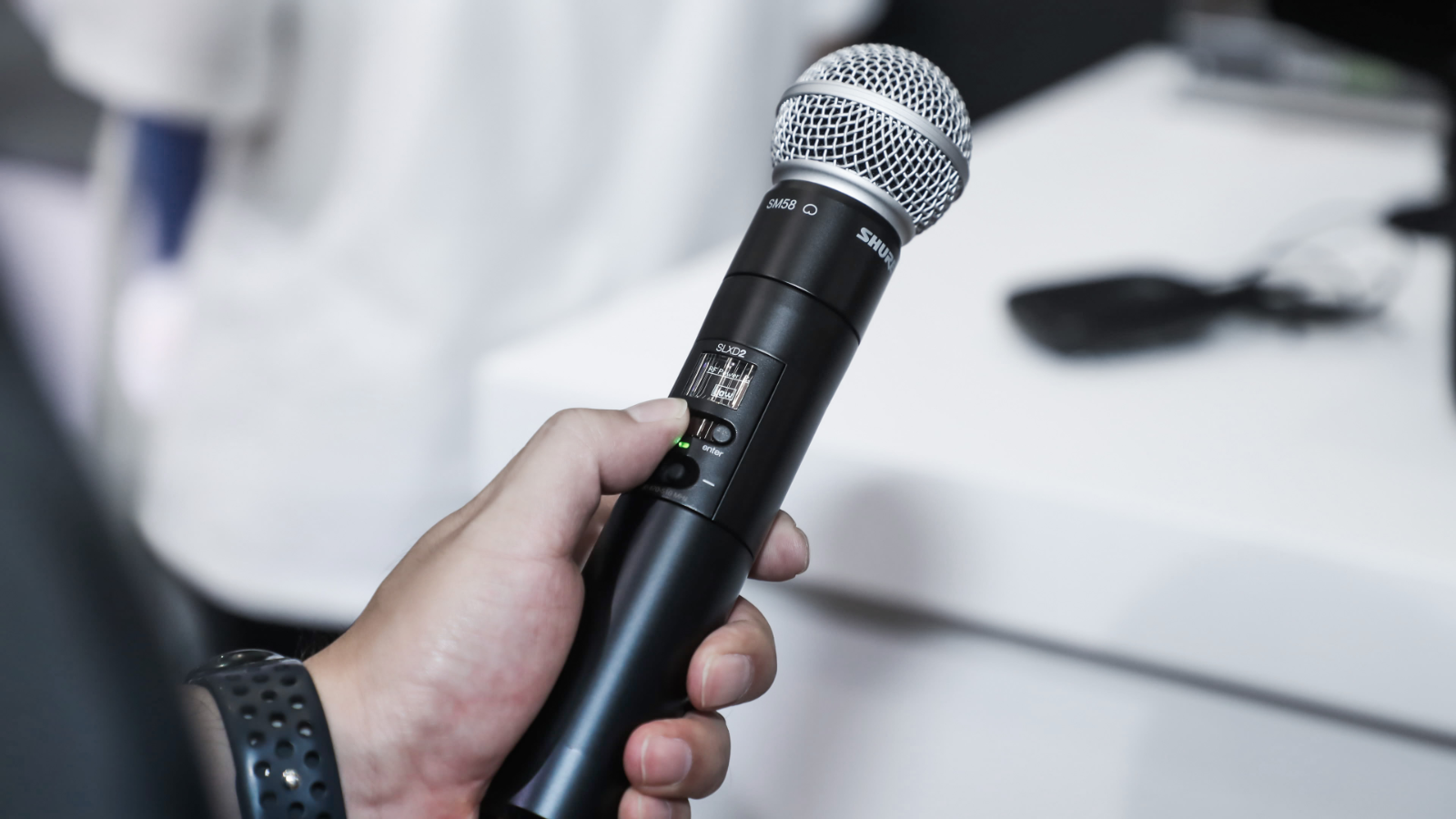 Ref: https://www.shure.com/en-ASIA/conferencing-meetings/ignite/tell-me-about-wireless-mic-frequencies
Ref: https://www.shure.com/en-ASIA/conferencing-meetings/ignite/tell-me-about-wireless-mic-frequencies
- Lavalier
Also known as lav or lapel microphones, lavalier mics are compact and discreet, designed to clip onto the speaker's clothing. Their close placement near the mouth ensures a strong signal-to-noise ratio, reducing common audio quality issues found with shotgun or on-camera mics.
Lav mics are often used in video and filmmaking where a visible microphone might be distracting or impractical. They connect to a transmitter pack, usually worn on the subject's belt, for hands-free operation. The NearStream AWM20T exemplifies this versatility, offering high-quality performance and being a top choice among content creators.
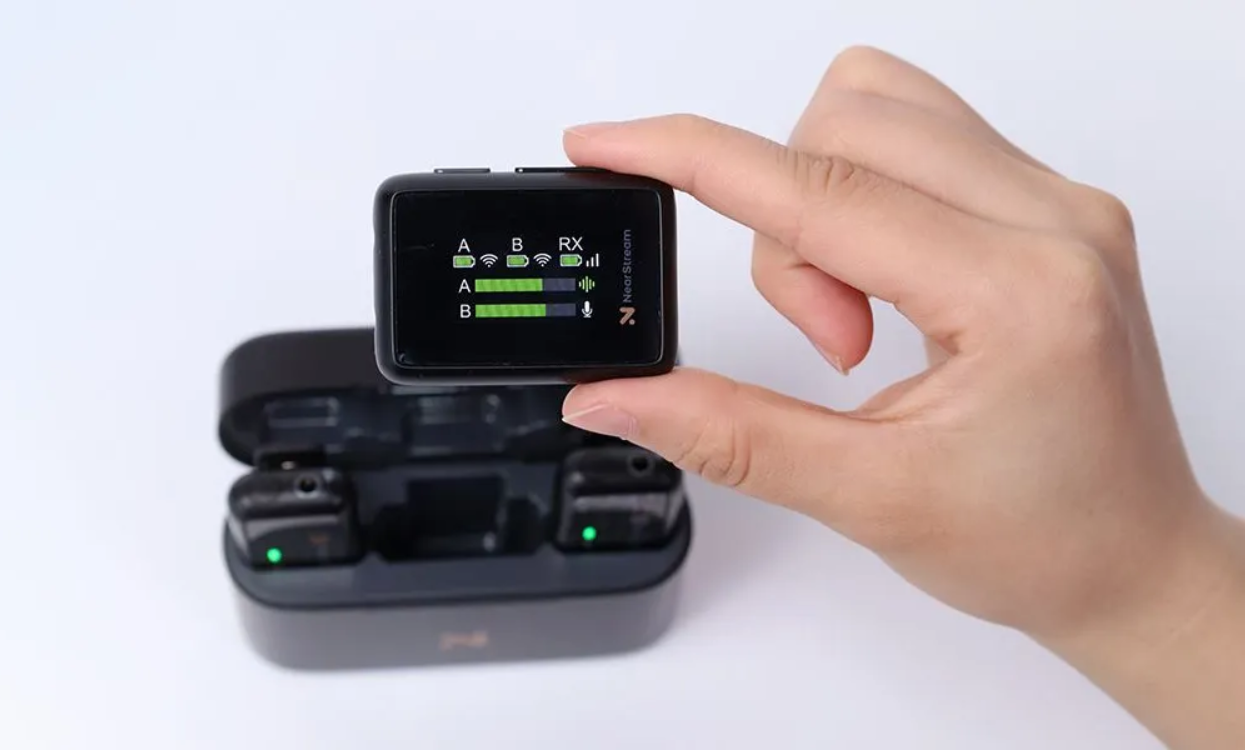
- Headset
Headset microphones are designed to be worn on the head, usually resting over the ear, with a flexible arm placing the mic capsule near the mouth. These mics are ideal for noisy environments or active situations, as they maintain a consistent distance from the mouth and allow users to operate hands-free.

Ref: https://www.jabra.com/blog/noise-cancellation-in-headsets-what-exactly-is-it/
Benefits of Going Wireless
Why go wireless? For artists, presenters, and performers, the answer is clear: it offers unmatched convenience. Just like our everyday devices rely on Wi-Fi and Bluetooth, wireless microphones provide greater freedom and ease, offering several benefits over wired options.
- Clean and Professional Appearance
Wireless microphones ensure a sleek, cable-free appearance, keeping your audience’s attention where it belongs. Whether you’re on stage performing or on camera delivering content, the absence of wires helps you maintain a polished and distraction-free presence, enhancing the visual impact of your presentation.
- Enhanced Freedom of Movement
A wireless microphone frees you from cables, letting you move seamlessly during content creation. You can navigate your entire set, engage directly with your audience, and even get creative with dynamic shots without being held back by cords. For instance, the AWM20T offers advanced digital transmission and near-zero latency, with a stable range of up to 656 feet in open environments.
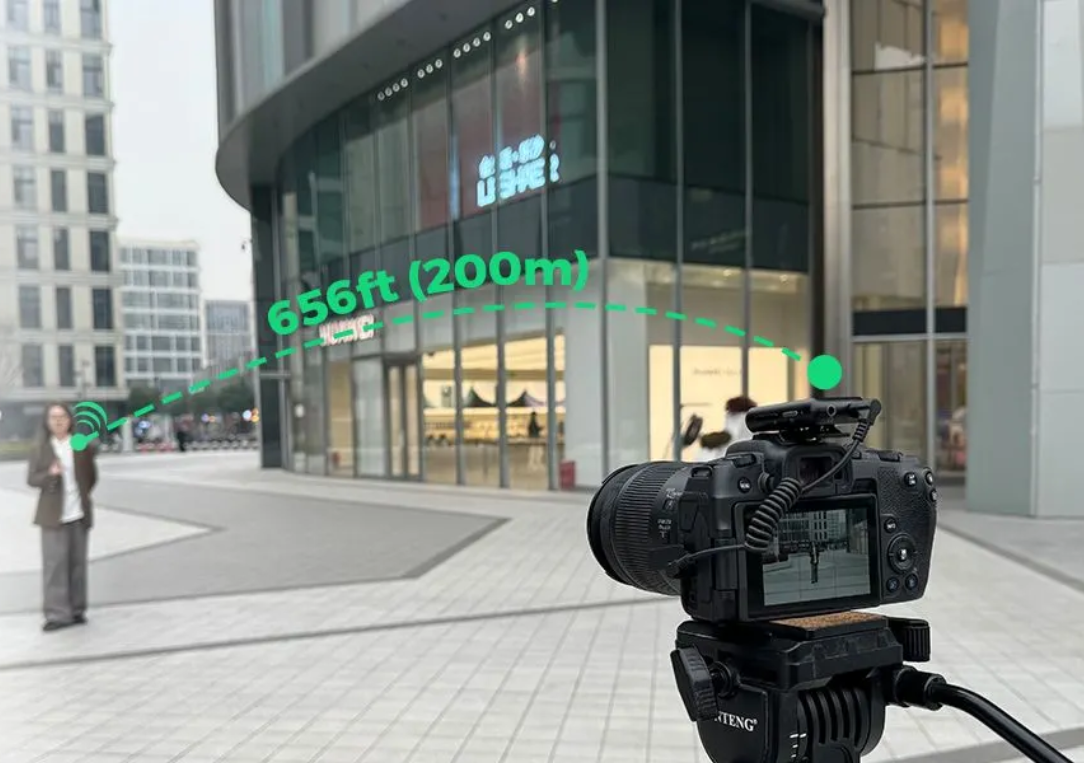
- Reduced Cable-related Issues
Microphone cables are prone to wear and tear, often needing replacement. They can also get damaged or disconnected during a performance, causing frustrating and potentially show-stopping interruptions. Going wireless eliminates these issues, offering reliable, uninterrupted performance without the hassle of tangled or faulty cables.
- Durable and Reliable
Wireless microphones are durable and reliable, designed to handle regular use without the wear of cables. They provide consistent audio performance and reduce the risk of interruptions, ensuring dependable operation for both on-stage and content creation environments.
How Does a Wireless Microphone Work?
Wireless microphone systems can elevate any performance, but they might seem complex at first glance. Understanding how these systems work can help you maximize their benefits. At the heart of these systems are two key components: the transmitter and the receiver.
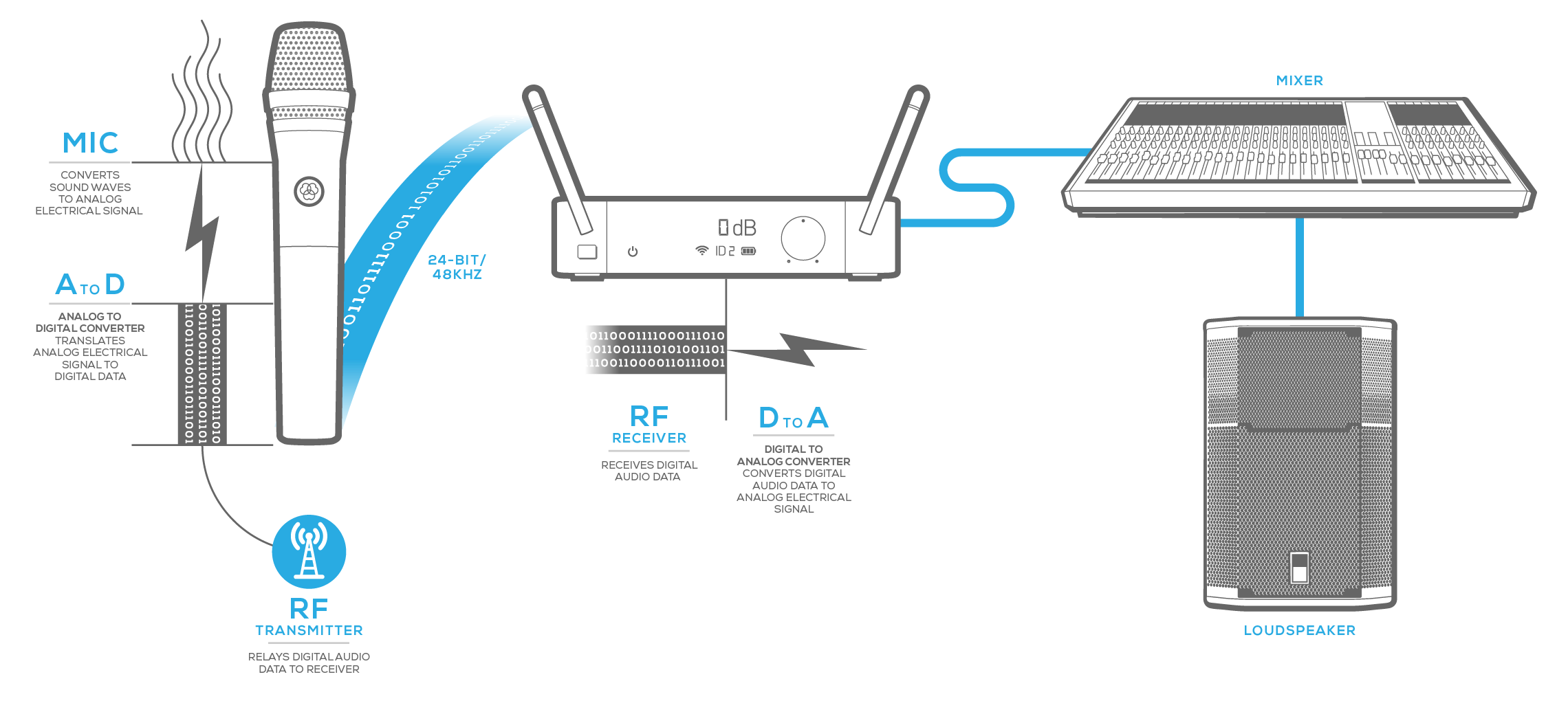
Ref: https://www.akg.com/comparing-digital-analog.html
- Transmitter
The transmitter takes the audio signal from the microphone and converts it into a radio signal. There are two main types:
Handheld transmitters integrate both the microphone and transmitter into one unit, making them easy to use and manage.
Bodypack transmitters are worn on a belt or guitar strap and connect to various microphones, including lavalier, headset, and clip-on instruments, as well as electric guitars and basses.
- Signal Transmission
The transmitter plays a crucial role in wireless microphone systems by turning audio signals into radio frequency (RF) signals that travel wirelessly to the receiver. Here’s a breakdown of how it works:
- Broadcasting Radio Frequency Signals
The microphone first picks up sound waves from your voice or other sources. It turns these sound waves into an electrical audio signal, which is a representation of the sound. This electrical signal is then sent to the transmitter.
Inside the transmitter, this audio signal is processed and strengthened to ensure it’s strong enough for transmission. Next, the transmitter combines this audio signal with a radio frequency (RF) carrier wave. Think of the carrier wave as a kind of “vehicle” that carries the audio signal through the air.
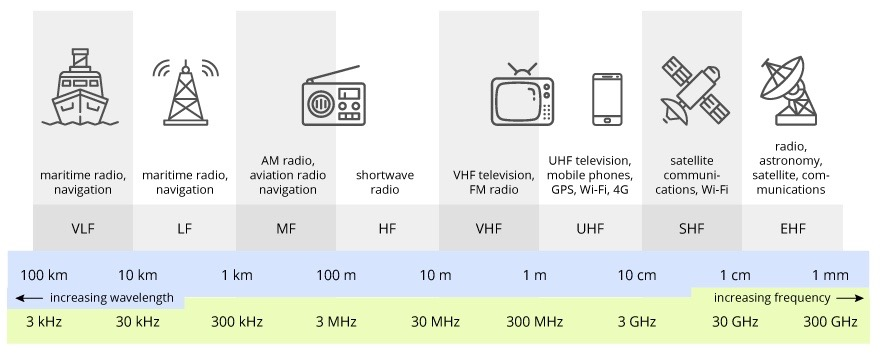
Ref:https://soundgirls.org/a-beginners-guide-to-wireless-frequencies/
This combination of the audio signal and the RF carrier wave is called modulation. The result is a stable RF signal that can travel wirelessly. The RF signal travels from the transmitter’s antenna and moves through the air to reach the receiver, which is designed to catch and decode this signal.
- Traveling Through the Air
Once the audio signal is combined with the radio frequency (RF) carrier wave, it’s sent out wirelessly through the air. The RF signal comes from the transmitter’s antenna and moves through the environment.
This signal can travel quite far, depending on the system's range and the surroundings. As it moves, it might run into obstacles like walls or furniture, which can weaken the signal a bit. But don’t worry—advanced wireless systems are built to manage these challenges and keep the signal strong over longer distances.
- Receiver
When the transmitter sends out its radio signals, the receiver’s antenna eagerly catches them. Inside the receiver, these signals undergo a magical transformation: the original audio is carefully extracted from the radio waves. This process, known as demodulation, brings the sound back to life. The receiver then boosts this audio signal and sends it out to speakers or recording gear, letting you hear or capture the sound with clarity and precision.

Ref: https://rode.com/en/about/news-info/a-beginners-guide-to-digital-wireless-microphone-systems
Receivers come in various types, each tailored to specific needs:
Modular Receivers: These units can be freestanding or mounted in racks, typically powered by AC. They are designed for stationary setups and offer reliable performance for various professional applications.
Portable Receivers: These are similar in appearance to bodypack transmitters but function as receivers. They are battery-powered, making them ideal for mobile use, such as in field recording or live events.
Guitar Pedal Receivers: Designed specifically for electric guitar and bass players, these receivers fit into a pedalboard setup. They allow musicians to connect wirelessly while keeping their gear organized and accessible.
Conclusion
Understanding wireless microphones can significantly enhance your content creation. From choosing the right type to mastering their operation, this guide equips you with the essentials. Take your content creation to the next level with a wireless mic!
NearStream VM33 - 2K HD Wireless Streaming Camera is an all-in-one wireless live streaming multicam with an optical lens, perfect for streamers seeking a second camera or for recording entire church, wedding, sports, conference, online meetings, or any live events. If you want higher quality, you can choose NearStream VM46 with a 4K resolution.













































